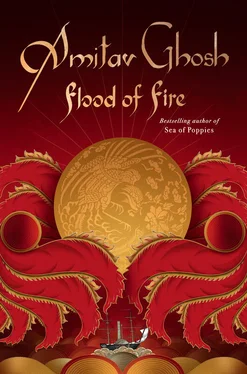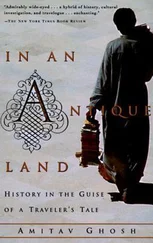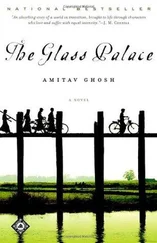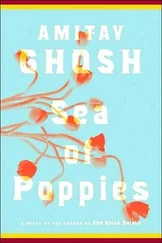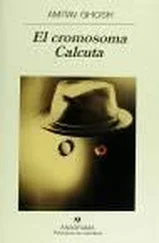The harbour at Humen is dominated by the customs house: this is where we had been told to go. On arriving there we learnt that the Royal Saxon was already at anchor nearby: the ship’s captain was under instructions to proceed to the customs house next morning, to sign the bond. But in the meantime, a squadron of British vessels, with Captain Elliot on board, had also sailed in from Hong Kong, no doubt with the intention of preventing the Royal Saxon from approaching Humen. Everyone was on edge, wondering what would happen the next day.
Compton had thought that we would stay either at the customs house in Humen or at a nearby yamen. But on inquiring we learnt that there was no room for us in either. We were told that we would have to make other arrangements. Although Compton was disappointed, I was relieved: it was clear that the customs house officials were suspicious of me despite my official credentials; I was none too keen to remain there.
We went into Humen, to look for an inn, but these too were filled to capacity: apparently a massive project is under way to strengthen the fortifications of the Tiger’s Mouth, and large numbers of workers and overseers have flooded into the town.
Fortunately, Compton has relatives nearby, which is only natural since he is a native of that county. They live in a hamlet, on a neighbouring island called Shaitok (foreigners call it Chuenpee). We took a ferry over and met with a warm welcome from Compton’s relatives.
In the late afternoon the boys of the house took us for a long walk. The island is lush and leafy, with two conical hills. But its prettiness is deceptive: like Humen, Chuenpee bristles with cannon. Right on the water, there is a massive gun-emplacement: it looks across the Tiger’s Mouth towards Tytock, on the far side of the channel, where there is another large battery. On the summit of Chuenpee’s tallest hill there is another fort, a small one. The hill commands a panoramic view of the surroundings. The landscape was breathtaking: it was as if a scroll-painting had appeared before my eyes. To the east the estuary broadens into a wide funnel, with Hong Kong on one side and Macau on the other; to the west, the Pearl River meanders through a verdant plain, heading off in the direction of Guangzhou. The water of the estuary is a brilliant, sparkling blue, broken here and there by forested islands. On the far shore there are jagged mountains, with misted peaks.
Compton had brought a telescope with him, and we took turns examining the ships below. The Chinese fleet was concentrated at Tytock, on the other side of the channel: it consisted of sixteen war-junks, with castella-tions, fore and aft. Matted sails hung from their masts, projecting obliquely upwards, like the wings of moths. They were bedecked with streaming pennants and banners, and their bows were decorated with large, painted eyes. They were certainly faa faa hik hik — extremely colourful in appearance, but in size they were small, no more than a hundred feet in length, about as much as the Ibis if not less. Even ordinary trading junks are larger; as for European vessels, even a sixth-rate British warship is far bigger and heavier.
Swarming between the war-junks were many small boats and a dozen or so rafts with black flags: these were ‘fire-vessels’ Compton said; they are used as incendiary weapons, to spread flames amongst enemy ships. Some of them also carry ‘stink-bombs’ — chemical devices that disperse noxious gases and fumes.
The British ships were a couple of miles to the east, where the estuary broadens. The squad was a small one, consisting of a couple of ships’ boats and two warships. By British standards these were small vessels, and far from fearsome; one was I think a sloop-of-war and the other a small frigate. I guessed that according to the Royal Navy’s scale of ratings, they were fourth-rate warships.
Between the two squadrons, like a plump fish caught between two schools of predators, was the Royal Saxon , anchored beside an island. Scanning her decks with a spyglass, I spotted many turbaned heads — lascars! I began to wonder how I’d have felt in their position, caught between British and Chinese warships?
On the way back to the hamlet, Compton said he thought the British warships would beih fung tauh — avoid trouble. There are just two of them, what can they do against sixteen ships?
I thought it best to say nothing.
Next morning we went back to the customs house at Humen. The officials told us that we would not be needed after all: a chop had already been issued to the Royal Saxon and she would soon be coming through, on her way to Whampoa.
There was nothing for us to do, so we decided to go back to Chuenpee to pick up our things. As we were approaching the hamlet, we saw the boys of the house running towards the top of the hill. We began to run too and soon caught up with one of Compton’s nephews. We went up the hill together and on reaching the top we saw that the Royal Saxon had hoisted sail and was heading towards the Chinese customs house at Humen. This had roused the two British warships to give chase: they were about half a mile behind her, with every mast and yard crowded with canvas.
All of this had happened very quickly, and the Chinese fleet was clearly taken unawares. The war-junks and even the smaller boats were still at their moorings; not a single vessel had budged.
The two British warships closed quickly on the Royal Saxon . First the frigate flashed warnings with her signal flags. Then, with a puff of smoke and a booming report, a single cannon-shot was fired across the Royal Saxon’s bows.
Compton, who was standing beside me, could not believe his eyes: Are they going to attack an English ship?
I told him that they weren’t really attacking the Royal Saxon — they were warning her not to break the embargo by proceeding to Canton.
The Royal Saxon had taken heed and had already begun to change course. She now tacked steeply to starboard. Meanwhile, the Chinese ships had begun to move too; led by the largest of the junks, they brought their bows around and began to advance towards the British ships.
The two English warships slackened pace a little, but when it became clear that the junks were on course to intercept them, the sloop fell behind the frigate, to form a line of battle.
The war-junks were now bunched together, with the fire-boats and rafts swarming between them. As the warships drew abreast, one of the fire-boats was set alight and pushed towards the approaching frigate. Neither of the warships veered from their course — the fire-boat was moving too slowly to do them any harm. Holding steady, the English ships closed to a distance of less than a hundred feet. When the Chinese squadron was directly a-beam of them, the frigate flashed a signal, and the two warships unloosed their first broadside.
Puffs of smoke blossomed along the starboard beams of both warships. By the time the sound had crossed the water, the Chinese fleet was obscured from our sight by a dense white cloud. Moments later a noise of a different kind came across — a sickening sound of splintering and crackling, pierced by screams and shouts.
When the smoke cleared the stretch of water where the Chinese fleet had been was utterly transformed: it was as if a sheet of lightning had come down from the sky, to set the channel on fire. Dozens of masts had been shattered; some had been blasted into the water and some had crashed down on the junks’ decks, killing and maiming the men below. A couple of junks were listing steeply, their bows rising as water flooded into their punctured hulls. Of the burning fire-boat nothing remained but a few, flaming pieces of wood. Around the wreckage, the water was churning with flailing limbs and bobbing heads.
Читать дальше
